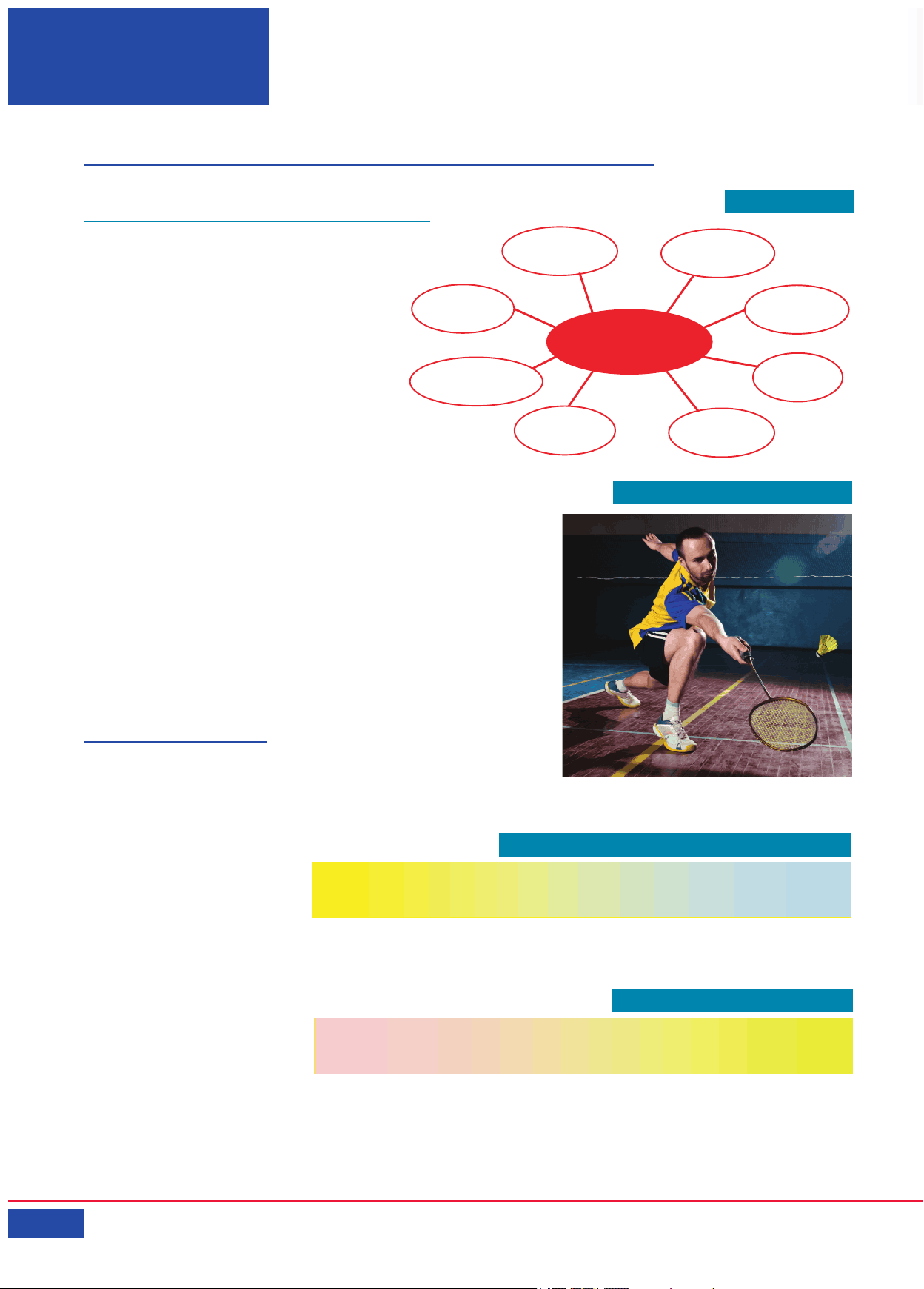
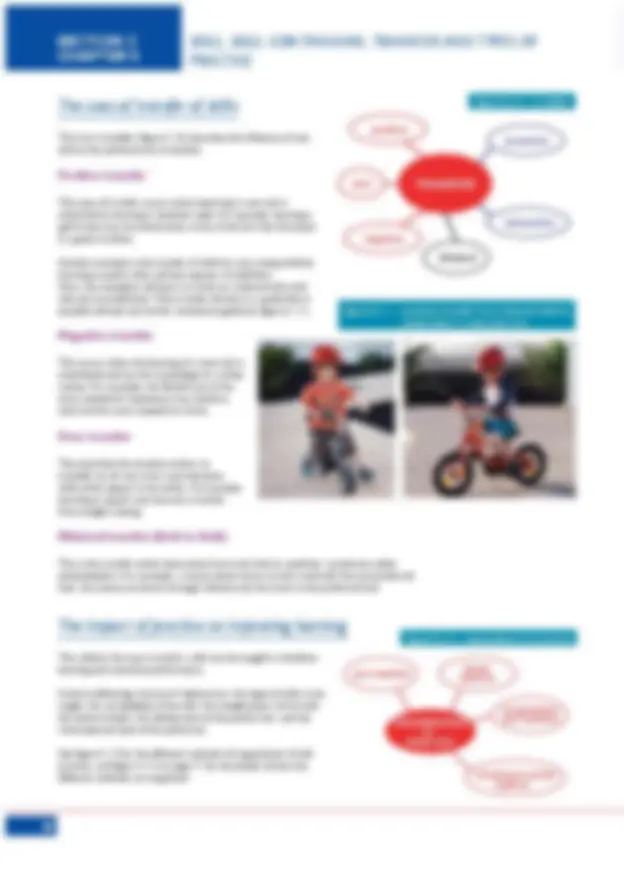
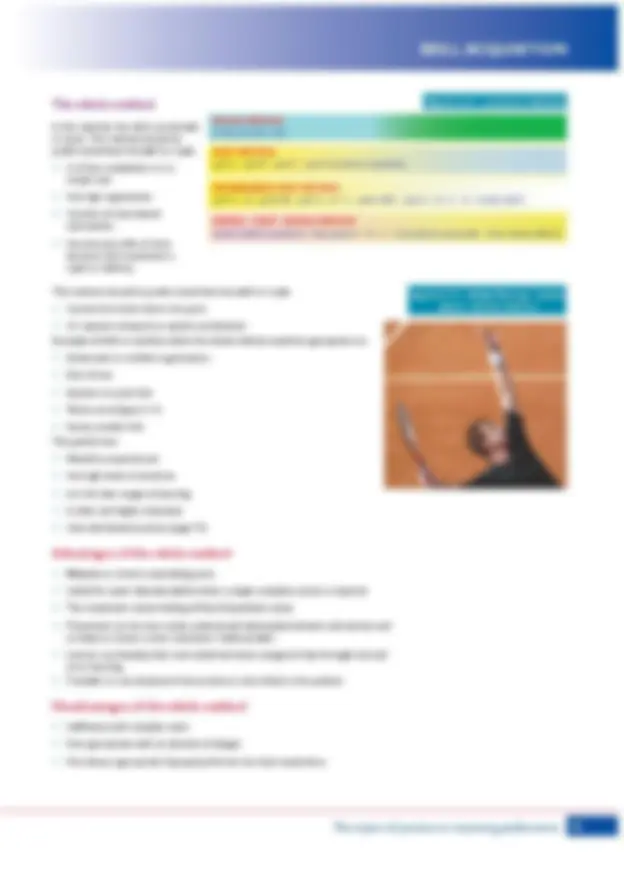
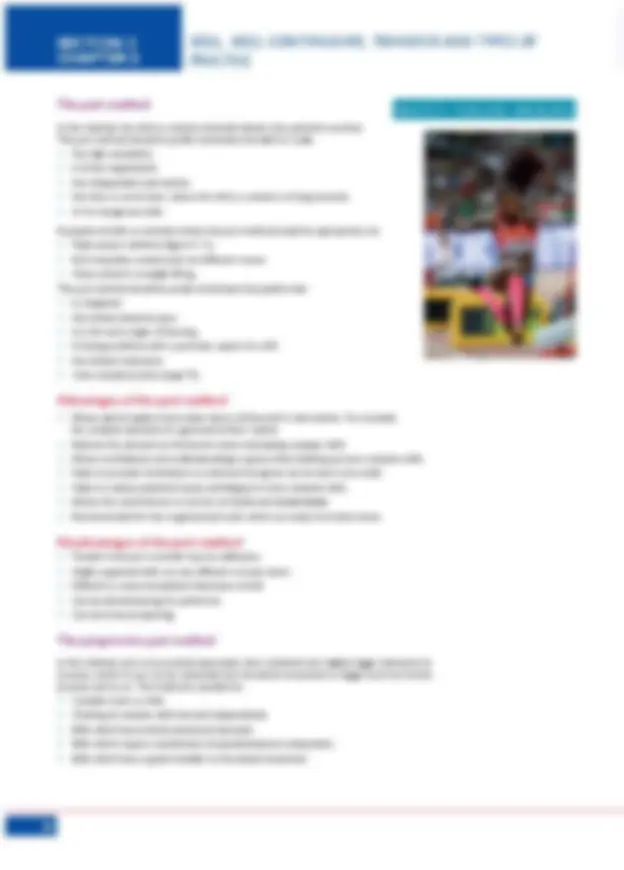
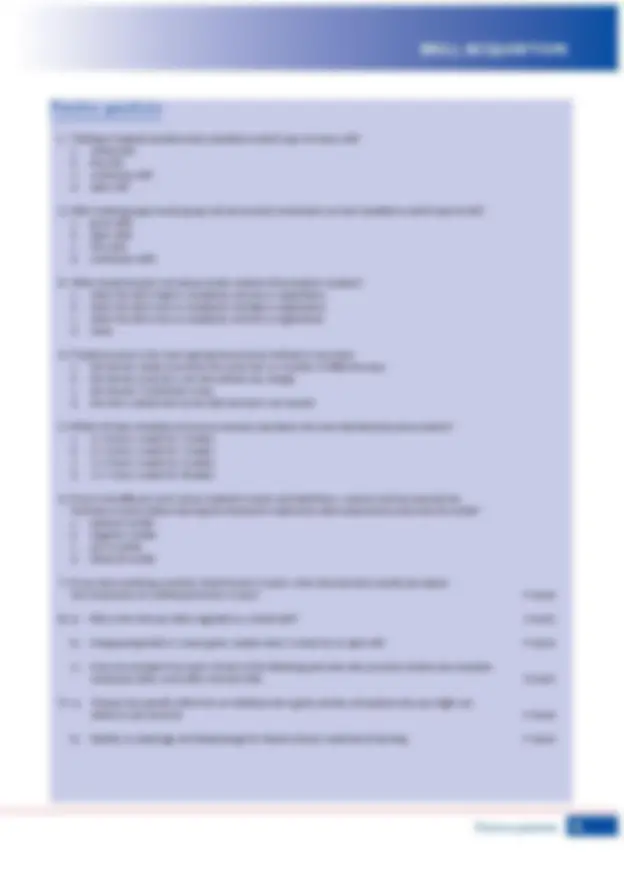
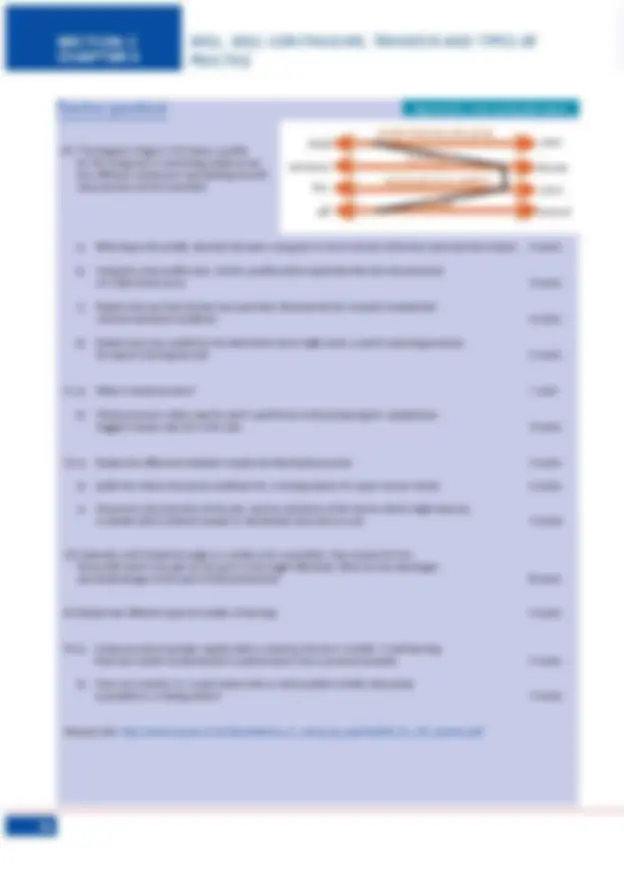


Study with the several resources on Docsity

Earn points by helping other students or get them with a premium plan


Prepare for your exams
Study with the several resources on Docsity

Earn points to download
Earn points by helping other students or get them with a premium plan
Community
Ask the community for help and clear up your study doubts
Discover the best universities in your country according to Docsity users
Free resources
Download our free guides on studying techniques, anxiety management strategies, and thesis advice from Docsity tutors
The concept of motor skills, their characteristics, classification, and transfer. Motor skills are coordinated, controlled, efficient techniques used in sports or games, or qualities possessed by sportspersons. Skills are classified based on environmental influence, continuity, muscular involvement, pacing, organization, and difficulty continuums. Transfer refers to the influence of one skill on the performance of another. positive, negative, zero, proactive, and retroactive transfer, as well as different methods of practice: whole method, part method, and progressive part method.
Typology: Lecture notes
1 / 9

This page cannot be seen from the preview
Don't miss anything!






CHAPTER 5 : Skill, skill continuums, transfer & types of practice
The term motor skill is used to describe a technique within a game or sport (for example, passing, hitting, catching, controlling a ball), or in reference to the sport itself (diving, tennis, hammer throwing), or a quality possessed by a sportsperson. The characteristics of skill (figure 5.1) are that it should be coordinated, controlled, with good technique, efficient, or predetermined by practice or the observation of others performing the skill perfectly. As such the skill will be well-learned, efficient and consistent. The beauty or pleasing nature of a skill is its aesthetic quality (figure 5.2).
A psychomotor skill is a voluntary body movement with a predetermined end result, for example, hitting a ball with a bat. Fundamental psychomotor skills are basic skills that are learned when young. They form the basis of more complex movements, for example, jumping. A perceptual skill is about being able to interpret information quickly at a given time and to make an appropriate decision. For example, a goalkeeper in football assessing the movement of an opponent approaching. A cognitive skill is about being able to make sense of a problem and to solve it. These skills affect perception.
Classification of skill
All skills are on a classification continuum. There are several types of continuum:
The environmental influence continuum deals with a range of skills labelled open to closed. Open skills are predominantly perceptual, with no clear beginning or end, are affected by environment, are externally-paced, in response to many actions of others. For example, receiving a pass at soccer or hockey. On the other hand, closed skills are predominantly habitual, with a clear beginning and end, and are not affected much by environment. For example, an athlete performing a shot putt. See further examples in figure 5.3.
The continuity continuum deals with discrete, serial and continuous skills. Discrete skills are those that have a clear beginning and end, for example, taking a penalty kick at soccer. Serial skills are those that have a number of discrete elements linked together. For example, the triple jump in which the hop, step and jump are linked into one movement. Continuous skills are those that cannot be split up very easily into subroutines, for example, a hockey player dribbling a ball. See further examples in figure 5.4.
SKILL, SKILL CONTINUUMS, TRANSFER AND TYPES OF
PRACTICE
co-ordinated
aesthetic
good efficient technique
pre-determined
consistent (^) learned
controlled
figure 5.1 – skill
OPEN CLOSED soccer soccer tennis tennis soccer shot goal save pass stroke serve penalty putt
figure 5.3 – the environmental influence continuum
DISCRETE SERIAL CONTINUOUS weight javelin high basketball running lifting throw jump dribble
figure 5.4 – continuity continuum
figure 5.2 – badminton, aesthetic?
The muscular involvement continuum
deals with gross and fine skills.
Gross skills are those that use large
muscle movements, for example,
weight lifting. Fine skills are those
that use small muscle movements,
for example, darts. See further examples in figure 5.5.
The pacing continuum deals with
self-paced and externally-paced
skills. Self-paced skills are those
in which the performer has control over movement, for example, serving in volleyball.
Externally-paced skills are those in which the environment has more control, for
example, blocking in volleyball. See figure 5.6 for further examples.
Skills with low organisation
are uncomplicated and have
little organisational structure and whose subroutines tend to be discrete and may be
practised separately. For example, swimming. Skills with high organisation have a
complex organisational structure with subroutines which are closely linked and cannot
be practised separately (the skill must be practised as a whole). They require far more
attention and concentration to be performed successfully, for example, the pole vault.
See figure 5.7 for further examples.
Simple skills are straightforward
skills with few subroutines requiring
little concentration and cognitive
activity on the part of the performer, for example, walking or running.
Complex skills are complicated skills requiring a lot of attention or practice, the
complexity of which can be perceived differently by different individuals. Complex
skills require a large number of (interlinked) subroutines, some of which may be
habitual and learned, which affects the ease with which the performer performs the
skill, for example, a gymnastic floor exercise. See figure 5.8 for further examples.
All skills have elements of all the classifications. For example, a golf swing may be
predominantly a closed skill but it can be affected by strong weather conditions which
would be an open skill characteristic. The swim start in figure 5.9 could be said to
have gross and closed characteristics, but is it also self-paced and discrete?
Most skills have characteristics which make them near one end of a classification
continuum. For example, a batsman in cricket as he plays a shot can be seen to
be performing more of an open skill than a closed skill (he has to adapt to the
speed and direction of the ball). But the cricket shot does have elements of closed
characteristics too. The player has learned particular shots and almost automatically
puts them into operation when the ball approaches at different speeds, with different
spin, and in different directions.
GROSS FINE weight javelin netball cricket golf ten pin darts/ lifting throw pass stroke shot bowling snooker
figure 5.5 – muscular involvement continuum
EXTERNALLY-PACED SELF-PACED yachting tennis soccer diving tennis weight receiving serve game serve lifting
figure 5.6 – pacing continuum
SIMPLE COMPLEX sprinting throwing gymnastic snooker gymnastic tumble floor exercise
figure 80 - difficulty continuum figure 5.8– difficulty continuum
LOW ORGANISATION HIGH ORGANISATION swimming cycling gymnastic move stroke pole vault
figure 81 - organisation continuumfigure 5.7– organisation continuum
figure 5.9 – swim start, gross and closed skill?
In this method, the skill is practised
in total. The method should be
preferred where the skill or task :
- Is of low complexity or is a simple task. - Has high organisation. - Consists of interrelated subroutines. - Has discrete skills of short duration (the movement is rapid or ballistic).
This method should be preferred where the skill or task :
- Cannot be broken down into parts. - Or requires temporal or spatial coordination.
Examples of skills or activities where the whole method would be appropriate are:
- Somersault or tumble in gymnastics. - Dart throw. - Snooker or pool shot. - Tennis serve figure 5.14. - Soccer penalty kick.
The performer :
- Would be experienced. - Has high levels of attention. - Is in the later stages of learning. - Is older and highly motivated. - Uses distributed practice (page 74).
- Wastes no time^ in assembling parts. - Useful for quick^ discrete skills^ where a single complete action is required. - The movement retains feeling of flow/kinaesthetic sense. - Movement can be more easily understood/relationship between subroutines and so helps to create a more consistent, habitual skill. - Learner can develop their own^ schema/motor programme s through trial and error learning. - Transfer^ to real situations from practice is more likely to be positive.
- Ineffective with complex tasks. - Not appropriate with an element of danger. - Not always appropriate if group/performer has basic experience.
WHOLE METHOD whole practice only
figure 83 - practice methods
PART METHOD part A - part B - part C - part D practiced separately
WHOLE - PART - WHOLE METHOD whole (ABCD) practiced - then parts A - B - C - D practiced separately - then whole (ABCD)
PROGRESSIVE PART METHOD part A - B - parts AB - part A - B - C - parts ABC - part A - B - C - D - whole ABCD
figure 5.13 – practice methods
figure 5.14 – Andy Murray - tennis serve - whole method
In this method, the skill as a whole is broken down into parts for practice. The part method should be preferred where the skill or task :
- Has high complexity. - Is of low organisation. - Has independent subroutines. - Has slow or serial tasks, where the skill as a whole is of long duration. - Or for dangerous skills.
Examples of skills or activities where the part method would be appropriate are:
- Triple jump in athletics (figure 5.15). - Full trampoline routine with ten different moves. - Clean and jerk in weight-lifting. The part method should be preferred where the performer : - Is a beginner. - Has limited attention span. - Is in the early stages of learning. - Is having problems with a particular aspect of a skill. - Has limited motivation. - Uses massed practice (page 74).
- Allows^ serial tasks^ to be broken down and learned in subroutines. For example, the complex elements of a gymnastics floor routine. - Reduces the demand on the learner when attempting complex skills. - Allows^ confidence^ and^ understanding^ to grow when building up more complex skills. - Helps to provide^ motivation^ to continue if progress can be seen to be made. - Helps to reduce potential^ injury^ and^ fatigue^ in more complex skills. - Allows the coach/learner to correct on^ faults^ and^ weaknesses. - Recommended for low organisational tasks which can easily be broken down.
- Transfer from part to whole may be ineffective. - Highly organised skills are very difficult to break down. - Difficult to create kinaesthetic feel/sense of skill. - Can be^ demotivating^ for performer. - Can be^ time consuming.
In this method, parts are practised separately, then combined into slightly bigger elements for practice, which in turn can be combined into the whole movement or bigger parts for further practice and so on. This method is suitable for:
- Complex tasks or skills. - Chaining of complex skills learned independently. - Skills which have limited attentional demands. - Skills which require coordination of spatial/temporal components. - Skills which have a good^ transfer^ to the whole movement.
figure 5.15 – triple jump - best by parts
SKILL, SKILL CONTINUUMS, TRANSFER AND TYPES OF
PRACTICE
Distributed practice is a method in which training sessions include rest intervals which could involve mental practice. Sessions would be short and spread over time with recovery periods between. Good for the beginner and most skill learning , gives time to recover physically and mentally and is good for potentially dangerous situations.
Massed practice is a method in which practice is done with no rest intervals with sessions long in duration. In this method, a single training session will last a relatively long time, and all the activities are performed one after the other. This method is good for ‘ grooving ’ of skills and to encourage an habitual response, is good for discrete skills of short duration, but can lead to fatigue and boredom and there may be elements of negative transfer.
Overlearning involves a learned skill that is habitual because of many repetitions. Such skills are performed ‘ automatically ’ in response to a game or sporting situation (stimulus). Hence attention can be directed peripherally to other elements of a game (for example, tactics or strategy).
Mental practice (figure 5.18) works by producing small muscle contractions in the same sequence as an actual practice, and since the gross movement of the skill does not actually happen, it prevents wear and tear.
Mental practice is defined as the cognitive (thinking) rehearsal of a physical skill without movement (figure 5.19).
- It creates a^ mental picture^ of a skill. - Can be used to^ simulate^ a whole movement sequence or just part of it. - Can be used to^ imagine^ and envisage success and avoid failure in a competitive situation. - Can provide a mental warm-up in order to promote a state of readiness for action. - And must be as^ realistic^ as possible to be effective. - Can be used during^ rest^ and^ recovery^ periods^ during^ a performance or in between performances. - Can be used to focus^ attention^ on important aspects of a skill. - Builds^ self-confidence^ for an upcoming performance. - Controls arousal^ and induce calmness before a performance. - Can be used to enable the learner to^ memorise^ a skill or movement more effectively.
USES OF MENTAL PRACTICE
simulate a whole movement sequence
prevents wear and tear
mental picture of a skill
imagine success or avoid failure mental warm-up, readiness for action
must be as realistic as possible
used during rest periods
small muscle contractions same as actual practice
control arousal before performance
building self-confidence (^) focus attention on important aspects of skill
figure 5.18– mental practice
SKILL, SKILL CONTINUUMS, TRANSFER AND TYPES OF
PRACTICE
figure 5.19– mental practice
Practice questions
Tackling in football would be best classified as which type of motor skill? a. closed skill. b. fine skill. c. continuous skill. d. open skill.
Skills involving large muscle group and less precise movements are best classified as which type of skill? a. gross skills. b. open skills. c. fine skills. d. continuous skills.
When should teachers introduce whole method of learning for students? a. when the skill is high in complexity and low in organisation. b. when the skill is low in complexity and high in organisation. c. when the skill is low in complexity and low in organisation. d. never.
Massed practice is the most appropriate practice method to use when: a. the learner needs to practice the same task in a number of different ways. b. the learner practices a set task without any change. c. the learner’s motivation is low. d. the task is simple and can be fully learned in one session.
Which of these schedules of practice sessions represents the most distributed practice session? a. 2 x 4-hour a week for 2 weeks. b. 4 x 2-hour a week for 2 weeks. c. 2 x 2-hour a week for 4 weeks. d. 2 x 1-hour a week for 8 weeks.
Due to the different wrist action involved in tennis and badminton, a person who has learned the forehand in tennis before learning the forehand in badminton often experiences what kind of transfer? a. positive transfer. b. negative transfer. c. zero transfer. d. bilateral transfer.
If you were watching a number of performers in sport, what characteristics would you expect the movements of a skilled performer to have? 4 marks
a) Why is the shot put often regarded as a closed skill? 2 marks
b) Using passing skills in a team game, explain what is meant by an open skill. 4 marks
c) Give one example from sport of each of the following and state why you have chosen your example: continuous skills, serial skills, discrete skills. 3 marks
b) Identify an advantage and disadvantage for whole and part methods of learning. 4 marks
Practice questions
Tackling in football would be best classified as which type of motor skill? a. closed skill. b. fine skill. c. continuous skill. d. open skill.
Skills involving large muscle group and less precise movements are best classified as which type of skill? a. gross skills. b. open skills. c. fine skills. d. continuous skills.
When should teachers introduce whole method of learning for students? a. when the skill is high in complexity and low in organisation. b. when the skill is low in complexity and high in organisation. c. when the skill is low in complexity and low in organisation. d. never.
Massed practice is the most appropriate practice method to use when: a. the learner needs to practice the same task in a number of different ways. b. the learner practices a set task without any change. c. the learner’s motivation is low. d. the task is simple and can be fully learned in one session.
Which of these schedules of practice sessions represents the most distributed practice session? a. 2 x 4-hour a week for 2 weeks. b. 4 x 2-hour a week for 2 weeks. c. 2 x 2-hour a week for 4 weeks. d. 2 x 1-hour a week for 8 weeks.
Due to the different wrist action involved in tennis and badminton, a person who has learned the forehand in tennis before learning the forehand in badminton often experiences what kind of transfer? a. positive transfer. b. negative transfer. c. zero transfer. d. bilateral transfer.
If you were watching a number of performers in sport, what characteristics would you expect the movements of a skilled performer to have? 4 marks
a) Why is the shot put often regarded as a closed skill? 2 marks
b) Using passing skills in a team game, explain what is meant by an open skill. 4 marks
c) Give one example from sport of each of the following and state why you have chosen your example: continuous skills, serial skills, discrete skills. 3 marks
b) Identify an advantage and disadvantage for whole and part methods of learning. 4 marks